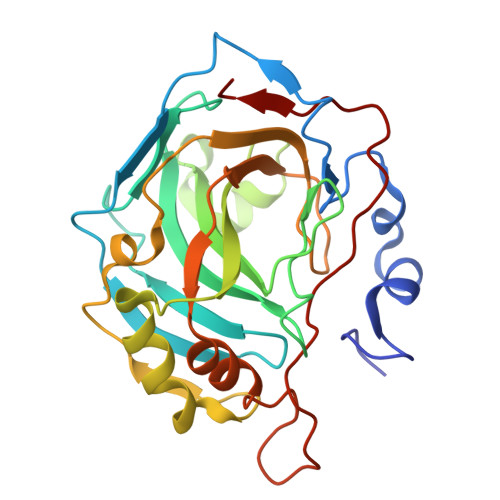Affinity and Selectivity of Protein-Ligand Recognition: A Minor Chemical Modification Changes Carbonic Anhydrase Binding Profile.
Zaksauskas, A., Paketuryte-Latve, V., Jankunaite, A., Capkauskaite, E., Becart, Y., Smirnov, A., Pospisilova, K., Leitans, J., Brynda, J., Kazaks, A., Baranauskiene, L., Manakova, E., Grazulis, S., Kairys, V., Tars, K., Rezacova, P., Matulis, D.(2025) J Med Chem 68: 17752-17773
- PubMed: 40801814
- DOI: https://doi.org/10.1021/acs.jmedchem.5c01421
- Primary Citation of Related Structures:
9FPQ, 9FPR, 9FPS, 9FPT, 9FPU, 9FPV, 9FPW, 9R8X, 9R8Y - PubMed Abstract:
Discovery of small-molecule drugs relies on their strong binding affinity compared to nontarget proteins, thus possessing selectivity. Minor chemical structure changes usually exhibit little change in the compound efficacy, with rare exceptions. We developed a series of nearly 50 ortho -substituted benzenesulfonamides and experimentally measured their interactions with the 12 catalytically active human carbonic anhydrase (CA) isozymes. Inhibitors were designed using seven different substituent groups, including 4- sulfanyl -substituted 3-sulfamoyl benzoates and benzamides, 4- sulfinyl -substituted 3-sulfamoyl benzoates and benzamides, 4- sulfonyl -substituted 3-sulfamoyl benzoates and benzamides, and 4-amino-substituted benzamides. The oxidation state of sulfur at the ortho position significantly influenced the compound's affinity for CAIX, a target for anticancer drugs, demonstrating affinities hundreds of thousands of times stronger than related compounds. Coupled with X-ray crystal structures and molecular docking, the relationship between structure and thermodynamics offers insights into how small changes in the structure lead to significant changes in affinity for drug design.
- Department of Biothermodynamics and Drug Design, Institute of Biotechnology, Life Sciences Center, Vilnius University, Saulėtekio al. 7, Vilnius LT-10257, Lithuania.
Organizational Affiliation:





















